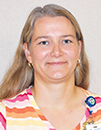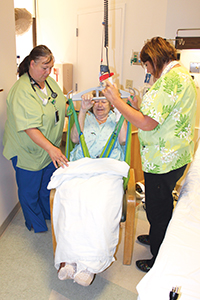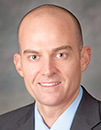By ELLEN FUTTERMAN

Certified nurse assistant Alexis Ross keeps her hand on a gait belt worn by Richard Bilodeau as he walks down a hallway at St. Vincent Healthcare in Billings, Mont. Patients at risk of falling wear gait belts and non-skid slippers when walking in the hospital.
(Photo by: Angela Douglas/St. Vincent Healthcare)
When Jena Riesinger took a nursing job at St. Vincent Healthcare in Billings, Mont., almost four years ago, her focus was on helping to save other people's lives, not worrying about her own safety. But as she and her colleagues have learned, hospital employees suffer injuries and illnesses at nearly twice the national average of workers in all industries — a total of more than 294,000 injuries in 2014, the most recent year numbers were available, according to the U.S. Bureau of Labor Statistics.
Strains, sprains and tears are the most common of these injuries, followed by overexertion and musculoskeletal disorders.
In an effort to reduce the number of injuries sustained by employees as well as increase communication throughout the hospital relating to safety, St. Vincent Healthcare established the Associate Safety Shared Learning Program in October 2012.
The program long proceeded the Occupational Safety and Health Administration decision in June 2015 to beef up its safety enforcement efforts in hospitals and nursing homes nationwide because too many employees were still getting hurt.
Listening to employees
The St. Vincent Healthcare program impacts all of the hospital's 2,200 employees, including nonmedical staff such as dietary workers, custodial staff, volunteers and other support personnel. "We identified some key areas that we felt we could improve such as lifting and handling patients and sharp safety, like punctures from needlesticks and cuts," said Jennifer Graves, director of quality at St. Vincent Healthcare. St. Vincent Healthcare is part of SCL Health, a faith-based nonprofit headquartered in Denver that operates hospitals and other health care facilities in Colorado, Kansas and Montana.

Graves
"We were looking for activities that promoted safety in general and were sustainable over time," she added.
Graves explained that the safety program consists of three key elements: safety walk rounds, safety "swarms," and daily safety huddles. Safety walk rounds connect the hospital's senior leadership, including its chief executive, with frontline employees to find out what gives them pause or concern regarding the safety of their patients and peers.
"This really reinforces for frontline associates how important safety is to that senior leader," said Graves. "We then have a process to create an action plan, making sure those concerns get addressed."
If not, why not?
When an injury does occur, the senior manager of that department, along with various others from hospital administration, human resources and public safety, will "swarm" the injured employee immediately to find out what happened in a face-to-face interview.

Hoffman
"In these safety swarms we want the employee to know we are sorry this incident happened to them, we want to know how it happened, and we want to do whatever we can to stop it from happening again," said Annette Hoffman, regional director of workers' compensation at St. Vincent Healthcare. "We then identify any action items — such as drying a slippery floor or clearing patches of ice from outside steps — decide who is going to be responsible for these action items by name and what date they will be completed. I follow up within 24 hours to make sure (these tasks) were successfully completed, and if not, why not."
Cause for concern
In addition, the hospital's various departments engage in daily "huddles" at the start of each 12-hour shift and managers use that opportunity to have employees discuss and problem-solve safety concerns.
"Most every department has a huddle," said Graves. "The first department huddle gathers frontline input. Then the manager of that department goes to the director who in turn goes to the senior leadership team. There are multiple layers where information is being reported and filtering upwards so that any safety issues — whether they affect a patient or an associate — come to the attention of the CEO and are adequately addressed."

St. Vincent Healthcare nurses Carmen Thomas, left, and Ginger Krook, right, use a lift to transfer patient Barbara Anderson from her bed to a chair. The equipment reduces the risk of injury to patients and staff.
(Photo by: Angela
Douglas/St. Vincent Healthcare)
Graves added that key to the success of the safety program is consistent follow-up and management of action plans by those involved. Using a simple chart kept in a common area that is easily accessible to employees, tasks are kept on schedule and accountability is maintained.
Safe transfers
"I think I can speak for my co-workers in saying that we know St. Vincent has made associate and patient safety a top priority," said Riesinger, adding that ongoing safety training takes place regularly. "Like a lot of hospitals, we have seen an increase in obese patients. In annual skills training we are checked and rechecked to make sure we move them safely. This is not only for their well-being but also to make sure we don't get hurt."
Riesinger said safety training also extends to employees caring for patients with emotional and behavior issues. "The primary concern is how do we protect ourselves and the patient who might become easily agitated, aggressive or even violent. We implemented a code gray to go over the intercom so that any employee nearby knows when another needs help. Security and a house supervisor can come to our aid immediately."
Since the rollout of the Associate Safety Shared Learning Program, more than 150 safety improvements have been made, said Graves. Among the program successes:
- A dramatic decrease in incident rates. While the U.S. Bureau of Labor Statistics reports the incident rate for hospitals was at 6.6, 6.4 and 6.2 per 100 full-time workers in 2012, 2013 and 2014 respectively — nearly double the rate for all industries in those years — during the same three years, St. Vincent Healthcare experienced an incident rate of 3.43, 2.58 and 1.62.
- The number of OSHA recordable injuries at St. Vincent Healthcare has steadily declined since 2011, from 45 that year to 15 in 2015. In addition, the average cost per claim plummeted from $3,203 in 2012 to $872 in 2015. This represents a cost savings of more than $564,000 in insurance claims during the three years of the program.

Loveless
While OSHA-recordable injuries have declined, the number of events reported has increased, showing a willingness of employees to report all types of injuries or near-injuries.
Behavior modification
"When we first started the program, we asked staff about the kind of lifting equipment we had, if they used it and what they needed to be safer," said Graves. "They told us not to waste our money on more of this equipment because they didn't have time to use it and there was no place to store it.
"Last year, Annette and I were doing some follow-up and kept hearing from staff how they could use more of this equipment. It was refreshing to get this feedback and know our associates have a commitment and willingness to use it because it is best for everyone's safety."
Given its success, principles of the safety program have been adopted systemwide, to include many of SCL Health's more than 17,000 medical and nonmedical employees, said Steve Loveless, St. Vincent Healthcare president and chief executive.
"We take pride in knowing that we are preventing injuries that were once occurring in our organization," said Loveless. "The additional value of 'safety,' adopted by SCL Health in 2014, aligns perfectly with our safety initiative and serves as a great platform to share how we value our associates and the work they do to bring about our healing ministry."
Copyright © 2016 by the Catholic Health Association
of the United States
For reprint permission, contact Betty Crosby or call (314) 253-3477.